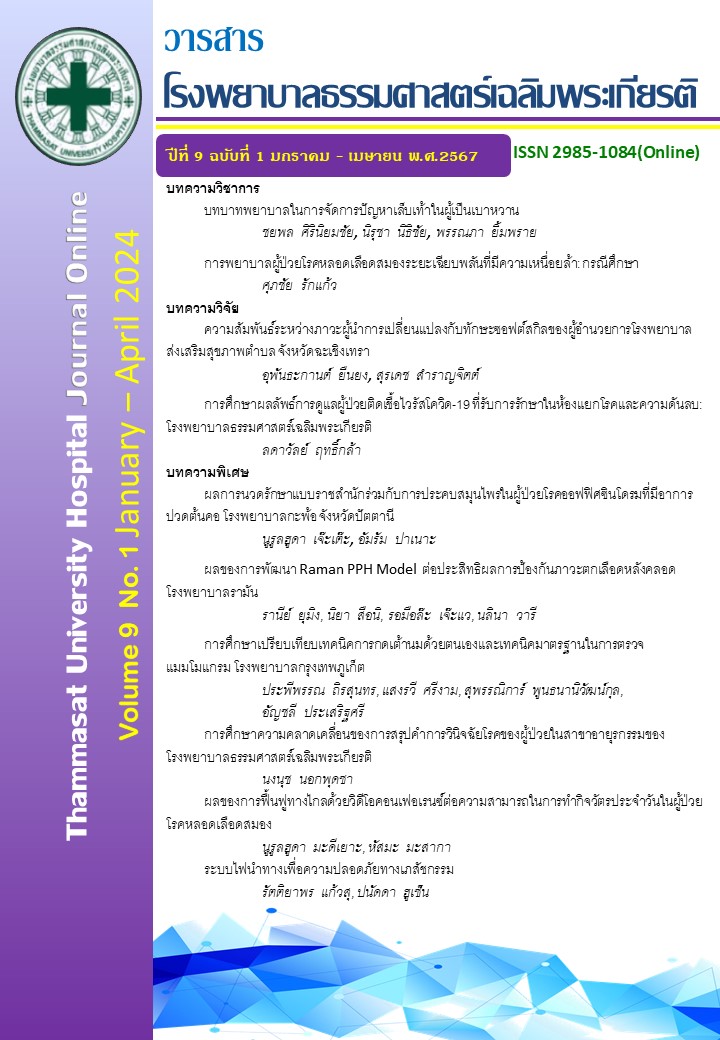Light Guiding Shelf (LGS) system for safety of pharmaceutical care
Keywords:
Light Guiding Shelf, Semi-Automatic Medication Dispenser, Medication errorAbstract
Background: Medication error is one of the important hospital problems. From 2020-2022, dispensing error rates were 3.33, 2.62, and 3.23 times per 1000 prescriptions respectively. In addition, there were three events this error with severity level E of sentinel event. The most inconsistent process is taking the wrong type of drug or the wrong strength. The Pharmaceutical department recognizes the importance of such problems and creates an LGS project that works with LED lights to identify drug locations. It can help to manage the corrected drug as effectively as possible.
Objective: 1. Reduce errors in the drug arrangement of wrong type or wrong strength medicine in outpatient dispensaries by more than 70.00 percent in fiscal year 2023. 2. Reduce errors in the drug arrangement of narcotics and case-specific drugs of the wrong type or strength by 100.00 percent in fiscal year 2023, including being to run reports on drug arrangement by 100.00 percent.
Material and methods: This project was conducted according to the Plan Do Check Act framework as 1. Install a drug cabinet and Light Guiding Shelf system with LEDs to indicate drug location. 2. Invented a drug access control system for narcotics and case-specific drugs. 3. Created a program to connect the LGS system with the hospital's program. 4. Arrange the drug by data processing into the computer with the hospital's program, send the data to the LGS system, pick up the drug according to the position of the LED light, and complete the process by turning off the lights. 5. Fixed errors and improved weak points caused by the system, collected data and analyzed performance results.
Result: 1. Pre-dispensing error rate in 2023 compared to 2022 decreased from 8.22 to 2.33 per 1,000 prescriptions (70.95% decrease). 2. The incidences of dispensing errors in 2023 compared to 2022 decreased from 16 to 3 times (81.25% decrease). 3. The incidences of dispensing errors with narcotic and case-specific drugs decreased from 1 to 0 times (100% decrease) and 100.00 percent of pharmaceutical arrangements report was achieved.
Conclusion: The Light Guiding Shelf (LGS) system is a semi-automated system that is suitable for the hospital context and costs less than other automated systems. LGS can effectively reduce the discrepancy of taking the wrong type of drug or the wrong strength. But it is also a system that relies on the human co-organization of drugs. So, this causes the opportunity to cause errors from not following the system. Therefore, monitoring and development are necessary to ensure further sustainability.
References
National Coordinating Council for Medication Error Report and Prevention (NCC MERP). NCC MERP Taxonomy of Medication Errors; [internet]. 2001 [cited 2023 Aug 14]. Available from: http://www.nccmerp.org/sites/default/files/taxonomy2001-07-31.pdf
เพียงเพ็ญ ชนาเทพาพร. ประสิทธิภาพและความปลอดภัยของระบบการจ่ายยาด้วยเครื่องจัดยา อัตโนมัติและอิเล็กทรอนิกส์จัดมือในผู้ป่วยในที่โรงพยาบาลศรีนครินทร์. ศรีนครินทร์เวชสาร 2563; 35(3): 311-319.
ภูรี อนันตโชติ และคณะ. การทดลองใช้และประเมินผลตัวชี้วัดสำหรับงานเภสัชกรรมโรงพยาบาล ศูนย์สารสนเทศและวิจัยระบบยา (ศสวย) [อินเตอร์เน็ต]. 2550 [เข้าถึงเมื่อ 10 สิงหาคม 2566]; 1:49-51. เข้าถึงได้จาก: https://kb.hsri.or.th/dspace/bitstream/handle/11228/643/hs1406.pdf?sequence=2&isAllowed=y
Downloads
Published
How to Cite
Issue
Section
License
Copyright (c) 2024 Thammasat University Hospital Journal Online

This work is licensed under a Creative Commons Attribution-NonCommercial-NoDerivatives 4.0 International License.



